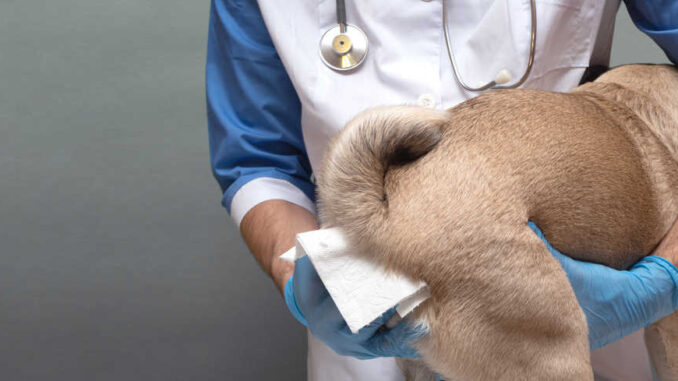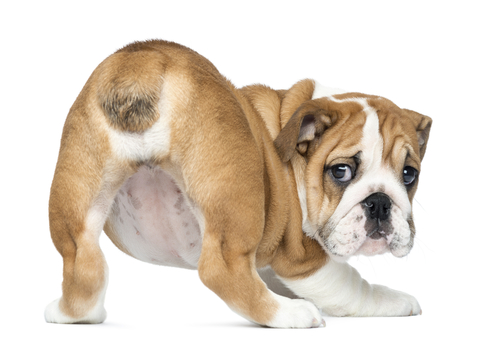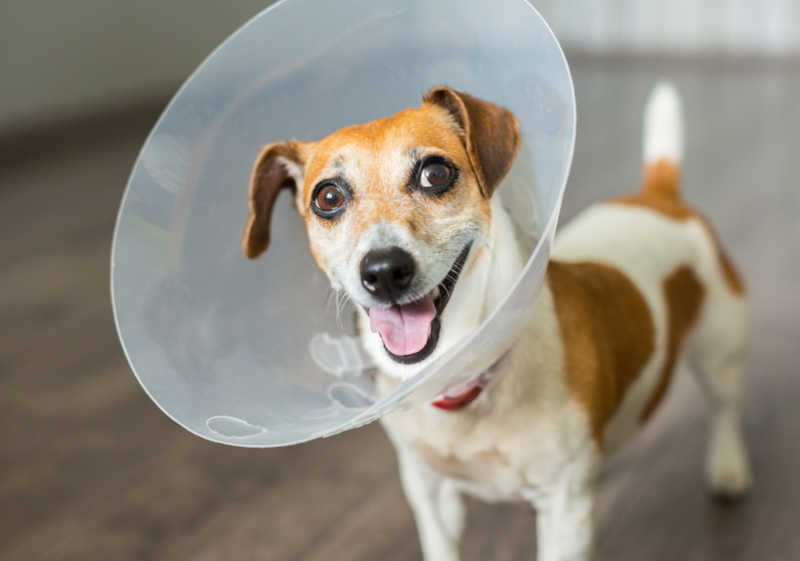
As a vet, I sometimes book in a client who thinks their dog may have hemorrhoids. However, while hemorrhoids can theoretically occur, it would seem they are vanishingly rare in our furry friends. Indeed, there is not a single reputable scholarly article or study that discusses the occurrence of canine hemorrhoids.
In 10 years as a veterinarian, caring for thousands of dogs, it is simply not something I have come across. So, when an owner calls me because they are suspicious of hemorrhoids, I can be fairly certain we are dealing with something else: from polyps and cancers to anal sac disease, there are lots of conditions that can be confused for hemorrhoids. In this article, we will find out what your dog could be suffering from, review the best treatments for these conditions.

Before starting treatment: does your dog really have hemorrhoids?
Before getting into treatments, let’s take a look at what a hemorrhoid is. Hemorrhoids are swollen veins just inside or outside of the anus that can cause discomfort. They may be visible as a red, blue or purple bulge that is shiny and smooth.
As a dog’s gastrointestinal system is “horizontal” rather than “vertical”, hemorrhoids are much less common when compared to humans. This is due to gravity, and the fact that a dog does not constantly have to battle its effects when the blood travels back to the heart.
Indeed, some vet experts think canine hemorrhoids may not exist, such as is discussed in this PetMD article.
The more common signs of hemorrhoids; like swellings, localised bleeding and visible masses, will usually be caused by something else entirely. So, hemorrhoids in dogs is a topic we need to approach with an open mind.
If not a hemorrhoid, what is going on with my dog?
So, we’ve established that we are probably not dealing with a hemorrhoid when there is something amiss with our dog’s back end. What else could be going on here? Let’s take a closer look at some of the more common “back end bothers”.
1. Anal sac disease.
The anal sacs are located either side of the anus, at about the 10 o’clock and 2 o’clock position of a clockface. They should be emptied each time a dog passes stool, but sometimes this mechanism goes wrong, and the fluid builds up. A build-up of fluid can lead to localised swelling and a dog can drag their bottom along the floor.
2. Rectal prolapse.
If a dog strains excessively, their rectum could prolapse so that it becomes visible. This tends to occur in younger pups and in those who have underlying issues such as parasites or chronic diarrhoea.
3. Anal polyp.
A polyp is a benign, non-cancerous growth that can grow on or near the anus of your dog. These tend to be smooth in appearance and grow slowly. These masses are often biopsied, to confirm they are not a cancer.
4. A tumor.
Cancers can appear anywhere on the body, including the anus. Cancers typically grow fast and the tissue involved may become ulcerated or infected. Cancerous growths are not always painful.
5. A localized infection.
When tissue becomes infected, we may see redness, swelling and discharge such as pus. There can be a smell and your dog might experience other signs such as a fever, lethargy and bum scooting.
6. Anal furunculosis.
This medical condition is most often seen in German Shepherds and their crosses. It can cause intense pain, trouble with passing stool and weight loss. We can see tracts around the anus. Anal furunculosis is managed with prescription diets, immune suppressants and pain relief.
7. Perianal hernia.
A swelling near the anus can occur when there is a hole in the muscle and some fat or an organ has “pushed through” under the skin. These are more common in certain breeds including the Corgi and Dachshund.
Treating options: an overview
Technically, there are two types of hemorrhoids: Internal and external. Only the external ones are visible to the naked eye. Internal hemorrhoids would only be detected on a rectal exam.
It is really not advisable to trial at-home treatment if you suspect hemorrhoids, whichever the type. The reason for this is that you likely are not dealing with hemorrhoids in your furry friend, so whatever is really going on, would be going untreated.
If you are wondering about hemorrhoids, it is time to book a vet check. The vet will discuss the best treatment option, which will be dependent on the diagnosis.
Home remedies and treatments for problems that mimic hemorrhoids
As discussed above, we should not try to treat suspected hemorrhoids from home. As true canine hemorrhoids are such a rare occurrence, we need to see the vet first, to ensure there is not something else going on.
If your dog is diagnosed with anal sac impaction, this can often be managed from home. Your vet can teach you how to regularly check and express glands, something which is best done in the bath! If your dog is scooting – check out the best home remedies to help a scooting dog (according to 2 of our veterinarians).
To ensure the dog expresses their own anal glands as the pass stool, we want them to pass a firm stool each day. If your dog’s stool is sloppy, it can help to:
• Offer a high fiber diet such as Wellness Core Digestive Health and consider adding unsweetened canned pumpkin to the diet
• Start daily probiotics. The ones I recommend at my clinic are Fortiflora by Purina.
• Ensure your dog’s wormer is up to date. This should be a broad-acting wormer that is effective against the most commonly seen parasites. For most mild cases of diarrhea, signs should resolve within just a few days.
If you do pick up on any signs of infection around your dog’s back end; such as a bad smell or skin that is discharging, we can gently wash the area with salt water once or twice daily.
If your dog is licking or chewing at their bottom, use a buster collar to make this impossible. It also helps to distract your dog with things like food puzzles, chews and interactive toys. This advice is especially important if there is a polyp or mass which might bleed.

FAQ about home remedies for hemorrhoids
Can you use an anti-inflammatory medication such as Ibuprofen?
Ibuprofen is never something we should give to our pet. This human medicine can be highly toxic to dogs and could result in stomach ulcers, liver disease and kidney failure. If your dog does need some pain relief or anti inflammatories, their vet will prescribe a medicine that is safe for dogs, such as Meloxicam or Prednisone. If you have given your dog Ibuprofen, contact your local vet clinic or pet poisons helpline right away.
Can you use over-the-counter hemorrhoid cream?
No, it is generally not advised to use these human medications on dogs. They are not licenced for dogs and may be toxic when ingested. If they are to be used, they would need to be prescribed by a vet who has seen the dog in person and feels a topical cream is the best treatment option.
Signs you shouldn’t try at-home remedies (time for a visit to the vet)
As mentioned, if you see something that makes you wonder if your dog has a hemorrhoid, you need to bring them to their vet. This is so we can be sure we know what we are dealing with and that we can start the right treatment plan.
Signs that warrant vet attention include:
• Ongoing bum scooting
• A bad smell coming from the back end
• Any visible protrusion from the anus
• A mass or swelling near the anus
• Discomfort when passing poo
• Chronic diarrhoea or constipation
• Vocalising when passing poo
Veterinary treatments for hemorrhoids in dogs
A vet will diagnose hemorrhoids by visibly assessing the anus, performing a rectal exam and ruling out any conditions that mimic hemorrhoids. Sometimes, imaging studies like x-rays and ultrasounds will be performed.
If a mass is detected, the vet might offer an FNA (fine needle aspirate) or biopsy, to check for cancer cells.
If the unexpected occurs and a vet does diagnose hemorrhoids, they would be treated with topical anti inflammatories, antibiotics if needed, dietary supplements and a prescription diet.
The theory is that any abnormal blood vessels should shrink back with time, as long as the dog is passing normal stools. If needed, an owner might use a buster collar in the meantime, to prevent any licking or chewing.
The cost of treating canine hemorrhoids ranges from about $60-$150 depending on the size of the dog and the length of time of the treatment course.
What are common underlying causes of hemorrhoids in dogs?
Hemorrhoids are usually linked to straining, which can be caused by hard stool, chronic diarrhoea, cystitis (bladder inflammation) bladder stones and local masses. It is thought that older dogs are more prone to hemorrhoids.
Certainly, if your dog has hemorrhoids or another issue which may be confused with hemorrhiods, we’d want to get to the bottom of what is going on with a prompt vet visit.
Disclaimer: This website's content is not a substitute for veterinary care. Always consult with your veterinarian for healthcare decisions. Read More.




Be the first to comment